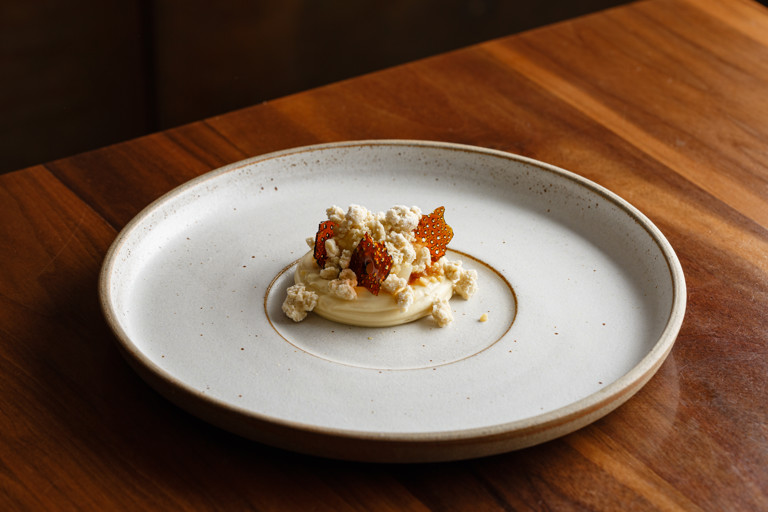Hay custard, Bramley apple, burnt sugar
Item 1 of 1
- medium
- 4
- 2 hours 10 minutes
Alex Bond's hay, apple and burnt sugar dessert is as delicious as it is resourceful – he uses Bramley apples to make a simple compote, but reserves the cores and peel to make a delicious apple and hay granita. Throw in a smooth hay custard and crunchy burnt sugar tuile and you have a seriously impressive dessert.
First published in 2020
discover more:
Ingredients
Metric
Imperial
Hay custard
- 600ml of double cream
- 85g of hay
- 90g of sugar
- 150g of egg yolk
Apple reduction
Apple compote
- 4 Bramley apples, peeled and cored (reserve the peel and cores for the granita)
- 1 knob of butter
Hay stock
- 100g of sugar
- 500ml of water
Apple and hay granita
- 1 pinch of citric acid
Burnt sugar tuile
- 100g of Isomalt sugar
- 100g of glucose
SAVE RECIPE
Equipment
- High-power blender
- Silpat mat
Method
1
Start off by toasting the hay. Preheat an oven to 180ºC/gas mark 4. Place the hay in a large roasting tray and toast in the oven for 40 minutes, turning every 10 minutes
- 85g of hay
2
Meanwhile, you can make the apple reduction – pour the apple juice into a pan and reduce to 200ml
3
Take the peeled Bramley apples and cut into 1cm dice, reserving any trim. Heat a knob of butter in a pan and cook the diced apple gently until tender but still holding its shape
- 4 Bramley apples, peeled and cored (reserve the peel and cores for the granita)
- 1 knob of butter
4
Meanwhile, cook the apple trim (but not the cores and peels) in a pan until very soft then blend into a smooth purée – you only need a little to bind the diced apple together. Mix the diced apple through the purée and store in the fridge until ready to plate
5
When the hay is toasted, remove from the oven and set aside 75g for the hay custard. Combine the other 10g of toasted hay with the sugar and water for the hay stock. Bring the mixture to the boil then remove from the heat and leave for 20 minutes to infuse. After this, you can strain the hay out of the stock and put the liquid in the fridge to chill
- 100g of sugar
- 500ml of water
6
To make the hay custard, take the other 75g of toasted hay and combine with double cream in a pan. Bring to the boil, then remove from the heat and leave to cool and infuse for about 20 minutes
- 90g of sugar
- 600ml of double cream
- 150g of egg yolk
7
Whilst the hay cream is infusing, you can make the burnt sugar tuile. Preheat the oven to 160ºC/gas mark 3. Combine the isomalt and glucose and pour onto a baking tray lined with baking parchment. Bake for 14 minutes until the mixture sets
- 100g of Isomalt sugar
- 100g of glucose
8
Once set, remove from the oven and blend into a fine powder. Turn the oven up to 200ºC/gas mark 5. Sieve the powder evenly over a Silpat mat – or baking paper – on a large baking tray and bake in the oven until the sugars turn a dark caramel colour and melt to form a clear sheet. At this point, remove from the oven, allow the sugar to cool and harden then break into shards and store in an airtight container
9
To finish the hay custard, strain the hay out of the cream and squeeze out any excess cream from the hay. Combine the hay cream, egg yolks and sugar in a mixing bowl and whisk over a bain-marie until the mixture reaches 83°C. When it reaches this point, blend with a hand blender until smooth, then transfer to a squeezy bottle and keep in the fridge until ready to plate
10
By this point the hay stock should be cold. Blend the reserved apple cores and peel with the cold hay stock, then pass the mixture through a fine sieve. Season the mixture with citric acid, then pour into a deep tray and freeze. Whisk the mixture every 10 minutes until it has frozen completely
- 1 pinch of citric acid
11
Once the granita has frozen solid, you're ready to plate. Pipe some of the hay custard onto the plate and create a small well in the middle with the back of a hot spoon. Fill the well with some of the apple reduction, then with a spoonful of the apple compote. Break some burnt sugar tuile over the top and finish with some of the granita
Get in touch
Please sign in or register to send a comment to Great British Chefs.


